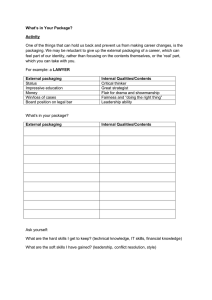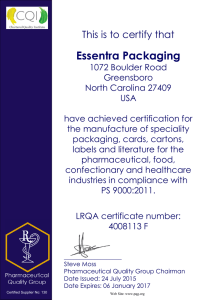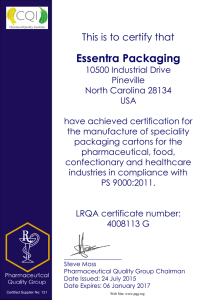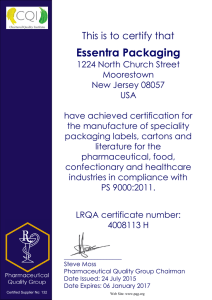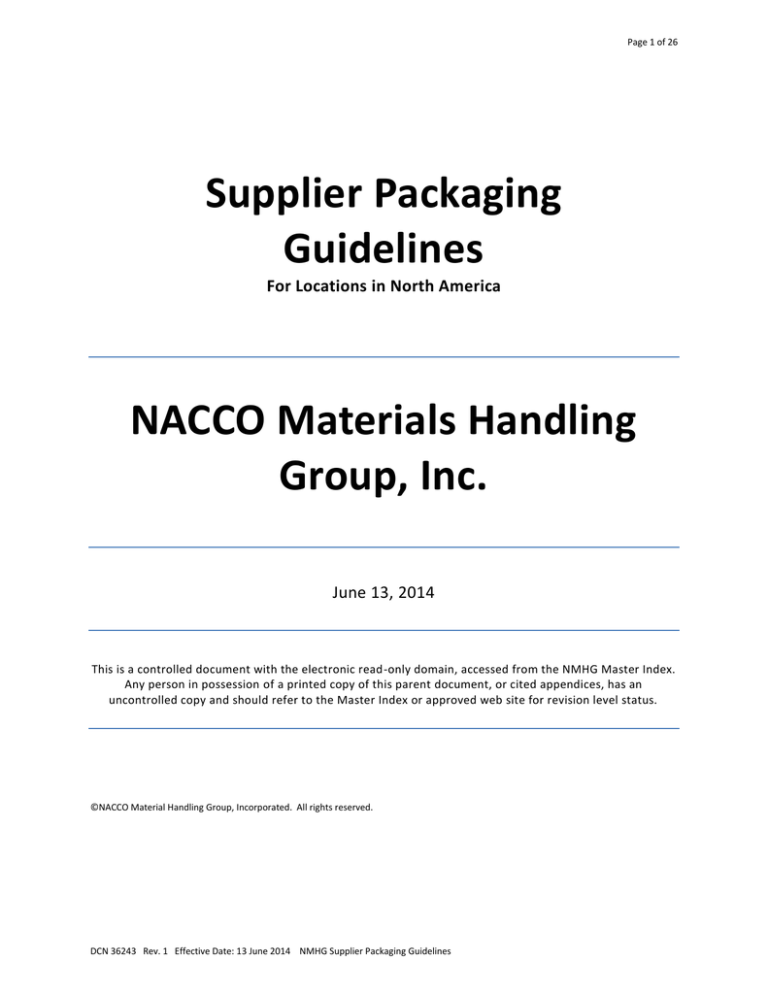
Page 1 of 26
Supplier Packaging
Guidelines
For Locations in North America
NACCO Materials Handling
Group, Inc.
June 13, 2014
This is a controlled document with the electronic read-only domain, accessed from the NMHG Master Index.
Any person in possession of a printed copy of this parent document, or cited appendices, has an
uncontrolled copy and should refer to the Master Index or approved web site for revision level status.
©NACCO Material Handling Group, Incorporated. All rights reserved.
DCN 36243 Rev. 1 Effective Date: 13 June 2014 NMHG Supplier Packaging Guidelines
Page 2 of 26
Table of Contents
1
2
INTRODUCTION......................................................................................................................... 4
1.1
SCOPE ................................................................................................................................. 4
1.2
PURPOSE ............................................................................................................................ 4
ACCEPTABLE PACKAGING .......................................................................................................... 4
2.1
EXPENDABLE PACKAGING ................................................................................................... 4
2.1.1
BAGS ........................................................................................................................... 4
2.1.2
CORRUGATED CARTONS............................................................................................... 5
2.1.2.1 MANUALLY HANDLED CARTONS ................................................................................. 5
2.1.2.2 CARTON STYLES AND MATERIALS ............................................................................... 5
2.1.2.3 CARTON SEALING ....................................................................................................... 8
2.1.2.4 BOX MAKER CERTIFICATE ........................................................................................... 9
2.1.2.5 FLUTE DIRECTION ....................................................................................................... 9
2.1.2.6 CARTON STACKING ................................................................................................... 10
2.1.3
INTERNAL PACKAGING ............................................................................................... 12
2.1.4
PALLETS ..................................................................................................................... 12
2.1.4.1 PALLET SIZES AND STYLES ......................................................................................... 12
2.1.4.2 PALLET CONSTRUCTION ............................................................................................ 15
2.1.4.3 EXPORT PALLETS ...................................................................................................... 15
2.2
RETURNABLE PACKAGING ................................................................................................. 16
2.2.1
INVESTMENT POLICY .................................................................................................. 16
2.2.2
ACCEPTABLE RETURNABLE PACKAGING STYLES .......................................................... 16
2.2.3
DESIGN CONSIDERATIONS .......................................................................................... 16
DCN 36243 Rev. 1 Effective Date: 13 June 2014 NMHG Supplier Packaging Guidelines
Page 3 of 26
2.3
LOAD CONTAINMENT ....................................................................................................... 17
2.3.1
STRETCH WRAP .......................................................................................................... 17
2.3.2
POLYESTER (PE) STRAPPING ....................................................................................... 18
2.3.3
SHRINK WRAP ............................................................................................................ 18
2.3.4
CORD STRAPPING....................................................................................................... 19
2.4
LABELING .......................................................................................................................... 19
2.4.1
BAR CODE LABELS ...................................................................................................... 19
2.4.2
TEST PACKAGE LABELS ............................................................................................... 19
2.5
PACKING SLIPS .................................................................................................................. 21
2.6
CONSISTENCY ................................................................................................................... 21
2.7
MIXED LOADS ................................................................................................................... 21
3
RESTRICTED PACKAGING ......................................................................................................... 22
4
PRESERVATION OF PRODUCTION MATERIALS .......................................................................... 22
4.1
CLEANLINESS .................................................................................................................... 23
4.2
CORROSION ...................................................................................................................... 23
4.2.1
OIL AND WAX BASED PRESERVATIVE OILS .................................................................. 23
4.2.2
VOLATILE CORROSION INHIBITORS (VCI) .................................................................... 23
4.2.3
DESICCANT................................................................................................................. 24
4.3
HYDRAULIC CLEANLINESS .................................................................................................. 24
4.4
CLASS A SURFACE.............................................................................................................. 24
4.5
CRITICAL MACHINED SURFACE .......................................................................................... 24
4.6
ELECTROSTATIC DISCHARGE (ESD) ..................................................................................... 24
4.7
GENERAL PRESERVATION REQUIREMENTS ........................................................................ 25
4.7.1
RIGHT SIZE PACKAGING .............................................................................................. 25
4.7.2
PART SEPARATION ..................................................................................................... 25
4.7.3
PART ORIENTATION ................................................................................................... 25
5
ERGONOMICS ......................................................................................................................... 26
6
CONTACT INFORMATION FOR QUESTIONS .............................................................................. 26
DCN 36243 Rev. 1 Effective Date: 13 June 2014 NMHG Supplier Packaging Guidelines
Page 4 of 26
1
1.1
INTRODUCTION
SCOPE
This document provides general guidelines on the minimum packaging requirements for
production materials shipped to the NACCO Materials Handling Group, Inc. (NMHG) North
American assembly and manufacturing facilities located in Berea, Kentucky; Greenville, North
Carolina; Ramos Arizpe, Mexico; and Sulligent, Alabama.
1.2 PURPOSE
The purpose of this document is to provide suppliers with concise guidelines for packaging
production materials at the lowest total cost by minimizing product damage, freight costs,
ergonomic hazards, material handling labor, and environmental impact.
A comprehensive Supplier Packaging Manual will be published during 2014 that will expand
upon these guidelines with detailed packaging requirements for specific production material
categories.
Due to the wide range of production materials used at the NMHG assembly and manufacturing
facilities and the condensed nature of these packaging guidelines, there are materials that will
exceed the parameters outlined in this document. For these materials, please contact
packaging@nmhg.com for additional direction.
NMHG Packaging is willing to partner with suppliers to establish sound, economical packaging
designs that promote efficiency throughout the entire supply chain. However, suppliers retain
the responsibility for providing damage free production materials shipped in the lowest total
cost package.
2
ACCEPTABLE PACKAGING
Acceptable packaging may be expendable or returnable, but must be of sufficient design and
strength to properly protect production materials throughout the entire supply chain. The
packaging selected for use must provide the lowest total cost.
2.1 EXPENDABLE PACKAGING
Expendable packaging is used a single time and must place an emphasis on recyclable materials.
2.1.1 BAGS
Bags are an acceptable primary package for smaller components, but will typically require a
secondary overpack such as a carton to ensure product protection.
Production materials in bags should be packed in quantities that are equal to the actual line
delivery quantity or a common multiple thereof.
DCN 36243 Rev. 1 Effective Date: 13 June 2014 NMHG Supplier Packaging Guidelines
Page 5 of 26
The preferred bag material is clear polyethylene for ease of recyclability.
Bag thickness must be a minimum 2 mil. Thicker gauges may be required based on the
application.
Bags may be sealed with zip locks, tape, twist ties, zip ties, or heat seals. Staples should not be
used.
2.1.2 CORRUGATED CARTONS
Corrugated (“cardboard”) cartons are one of the most common forms of packaging, and are a
preferred expendable package due to their ease of recyclability.
2.1.2.1 MANUALLY HANDLED CARTONS
Corrugated cartons that are intended to be manually handled must comply with the following
size and weight limits:
Maximum width of 20 in. (508 mm)
Maximum gross weight of 35 lbs. (16 kg.)
2.1.2.2 CARTON STYLES AND MATERIALS
Corrugated cartons are available in a wide variety of sizes, styles and material strengths.
Common styles of corrugated cartons that are most conducive to the NMHG assembly and
manufacturing operations are regular slotted cartons (RSC), half slotted cartons (HSC), and
when additional carton strength is required – full telescoping cartons (FTC).
Regular Slotted Carton (RSC)
Half Slotted Carton (HSC) may also require a lid
DCN 36243 Rev. 1 Effective Date: 13 June 2014 NMHG Supplier Packaging Guidelines
Page 6 of 26
Full Telescoping Carton (FTC)
The table on Page 8 may be used as a guide for selecting the appropriate corrugated material
based on the gross weight of the carton being shipped. Referenced within this table are test
strengths and wall types. There are two tests used to determine the strength of corrugated
cartons – Mullen Burst Test and Edge Crush Test. Cartons are readily available in three
different wall types or thicknesses.
The Mullen Burst Test is a measure of the force required to burst or rupture the side of a
corrugated carton. If a carton will be handled individually and exposed to rough handling, use
this test for material selection.
The Edge Crush Test (ECT) measures the stacking, or top-to-bottom compression, strength of a
corrugated carton. If cartons will be shipped in uniform pallet loads, and/or have the potential
for additional loads to be stacked on top use the ECT for material selection.
The three most common corrugated board thicknesses are single wall, double wall, and triple
wall. Corrugated board is made from a combination of paper sheets called liners glued to a
corrugated inner medium referred to as the flute. Single wall corrugated board correlates to a
single fluted medium, double wall has two fluted mediums, and triple wall has three fluted
mediums. The three board thicknesses are illustrated below.
DCN 36243 Rev. 1 Effective Date: 13 June 2014 NMHG Supplier Packaging Guidelines
Page 7 of 26
Also available, but not listed in the provided table, are multiwall corrugated boards containing
four or more fluted mediums. These multiwall boards are used to manufacture heavy duty
cartons such as may be required for bulk loads of raw castings or other heavy weight
production materials.
DCN 36243 Rev. 1 Effective Date: 13 June 2014 NMHG Supplier Packaging Guidelines
Page 8 of 26
Maximum Gross Weight Minimum Mullen Burst Minimum Edge Crush
Carton and Contents
Test Strength
Test Strength (ECT)
(lbs.)
(lbs. per sq. in.)
(lbs. per in. width)
Single Wall Corrugated Cartons
20
125
23
35
150
26
50
175
29
65
200
32
80
250
40
95
275
44
120
350
55
Double Wall Corrugated Cartons
80
200
42
100
275
48
120
350
51
140
400
61
160
500
71
180
600
82
Triple Wall Corrugated Cartons
240
700
67
260
900
80
280
1100
90
300
1300
112
2.1.2.3 CARTON SEALING
Corrugated cartons should be securely sealed with 2” (51 mm) wide pressure sensitive tape or
an adhesive specifically designed for carton sealing. Carton sealing must be strong enough to
insure that the unsupported bottom of manually handled cartons can hold the net weight of
the contents.
Staples should not be used to seal cartons. Staples are only allowed on the stitched
manufacturer’s joints and lid flaps of heavy duty, multi-wall (double wall and thicker) cartons
where tape or glue is inadequate.
DCN 36243 Rev. 1 Effective Date: 13 June 2014 NMHG Supplier Packaging Guidelines
Page 9 of 26
2.1.2.4 BOX MAKER CERTIFICATE
All cartons should be printed with the box maker’s certificate identifying test strength and wall
type as illustrated below.
2.1.2.5 FLUTE DIRECTION
The corrugated flutes should run vertically for maximum carton stacking strength.
DCN 36243 Rev. 1 Effective Date: 13 June 2014 NMHG Supplier Packaging Guidelines
Page 10 of 26
2.1.2.6 CARTON STACKING
Two-thirds of the stacking strength of a corrugated carton is concentrated at the corners. Stack
cartons on a pallet with the corners aligned, and the cartons within the perimeter of the pallet
for maximum stacking strength.
Misaligned carton corners can reduce stacking strength by up to 30%.
DCN 36243 Rev. 1 Effective Date: 13 June 2014 NMHG Supplier Packaging Guidelines
Page 11 of 26
Interlocked stacking patterns can reduce stacking strength by up to 50%.
Carton overhang off the pallet can reduce stacking strength by up 32%.
DCN 36243 Rev. 1 Effective Date: 13 June 2014 NMHG Supplier Packaging Guidelines
Page 12 of 26
2.1.3 INTERNAL PACKAGING
Internal packaging consists of a wide range of materials and components that protect
production materials from shock, vibration, and abrasion. As with all expendable packaging, it
is important to focus on recyclable materials. Corrugated or other paper based inserts and
separators are acceptable; as well as, polyethylene based sheeting and air-filled cushioning.
2.1.4 PALLETS
All pallets larger than 32” X 30” (813 mm X 762 mm) must be four-way entry to allow fork
access on all sides for maximum material handling efficiency.
Expendable pallets may be made of wood or paper based materials. Wood pallets may be
made of lumber or plywood. Acceptable paper based materials for pallet constructions include
corrugated boards, convolute tubes, and Kraft honeycomb.
2.1.4.1 PALLET SIZES AND STYLES
Acceptable pallet sizes and payloads are listed in the following table.
Pallet Size
Maximum Load Height
Maximum Gross Payload
Including Pallet
32” X 30” (813 mm X 762 mm)
(32” X 32” is allowable)
15” (381 mm)
2500 lbs. (1136 kg)
42” X 32” (1067 mm X 813 mm)
24” (610 mm)
3250 lbs. (1477 kg)
48” X 40” (1219 mm X 1016 mm)
48” (1219 mm)
4875 lbs. (2216 kg)
48” X 45” (1219 mm X 1143 mm)
54” (1371 mm)
4875 lbs. (2216 kg)
DCN 36243 Rev. 1 Effective Date: 13 June 2014 NMHG Supplier Packaging Guidelines
Page 13 of 26
The 32” X 30” pallet style must be double face reversible as shown below to allow use on roller
conveyors.
DCN 36243 Rev. 1 Effective Date: 13 June 2014 NMHG Supplier Packaging Guidelines
Page 14 of 26
Acceptable styles for the other pallet sizes are flush stringer style (double face, nonreversible)
and block style with full overlap base.
DCN 36243 Rev. 1 Effective Date: 13 June 2014 NMHG Supplier Packaging Guidelines
Page 15 of 26
2.1.4.2 PALLET CONSTRUCTION
Wood pallets should be fabricated in general accordance with the current Good Manufacturing Practices
outlined in the latest version of the Uniform Standard for Wood Pallets published by the National Wooden
Pallet and Container Association (www.palletcentral.com).
Wood pallets should be assembled with minimum 2.25” (57 mm) helically or annularly threaded nails for
maximum holding power.
Top and bottom deck boards should be a minimum 3.5” (89 mm) wide and 0.5” (13 mm) thick. Deck board
spacing must provide full support to the production material. There should be no missing or broken top or
bottom deck boards.
Stringer style pallets must have a minimum of three stringers. Each stringer must be a minimum of 1.5” (38
mm) wide X 3.5” (89 mm) tall (nominal 2”X 4” (51 mm X 102 mm) lumber) in order to maintain a minimum
3.5” (89 mm) high fork entry opening. For four-way entry, each stringer must have two notches 2” (51 mm)
to 2.5” (64 mm) high and 9” (229 mm) long on 24” (610 mm) centers to allow side fork entry. There should
be no missing or broken stringers.
Block style pallets must be fabricated with a minimum of nine blocks. Each block must have the minimum
block dimensions of 3.5” X 3.5” X 3.5” (89 mm X 89 mm X 89 mm) in order to maintain a minimum 3.5” (89
mm) high fork entry opening. There should be no missing or broken blocks.
As indicated, the above dimensions are the minimums. Larger deck boards, stringers, or blocks may be
required depending upon the load configuration and/or payload.
Paper based pallets should be constructed with water resistant adhesives versus staples or other mechanical
fasteners that may adversely affect recycling efforts.
2.1.4.3 EXPORT PALLETS
Wood pallets that will be shipped internationally must comply with the latest version of the International
Standards for Phytosanitary Measures, ISPM No. 15, Regulation of Wood Packaging Material in International
Trade (www.ispm15.com).
DCN 36243 Rev. 1 Effective Date: 13 June 2014 NMHG Supplier Packaging Guidelines
Page 16 of 26
2.2
RETURNABLE PACKAGING
Returnable packaging is acceptable when it provides the lowest total cost. Returnable packaging proposals
must undergo a thorough financial feasibility analysis by NMHG Packaging to confirm that all associated
expenses are accounted for.
Returnable packaging is used repeatedly over multiple years and must place an emphasis on durability in
material selection and design.
Back up expendable packaging of like dimensions and net quantity of contents must always be readily
available to cover potential disruptions in the flow of returnable packaging.
2.2.1 INVESTMENT POLICY
NMHG’s investment policy on returnable packaging is that the packaging will be purchased by the supplier
with reimbursement provided through a piece price amortization process. The supplier purchase policy
applies to initial returnable packaging purchases and associated maintenance expenses, as well as,
supplemental purchases to cover attrition, volume increases, etc. NMHG will be responsible for freight
expenses.
2.2.2 ACCEPTABLE RETURNABLE PACKAGING STYLES
A wide variety of returnable packaging styles are in use at the NMHG assembly and manufacturing facilities
including, but not limited to the following.
Custom steel shipping racks
Bulk bins
Bulk tubs
Layer packs
Dedicated pallets
Spools
Custom thermoformed tray packs
Sleeve packs
Hand totes
2.2.3 DESIGN CONSIDERATIONS
The following features should be taken into consideration when designing returnable packaging.
DCN 36243 Rev. 1 Effective Date: 13 June 2014 NMHG Supplier Packaging Guidelines
Page 17 of 26
2.3
Orientation of the production material within the package to insure part protection and ergonomic
access during loading and unloading.
Secure containment of the production material with minimal internal packaging and labor
requirements.
Package dimensions compatible with applicable freight conveyances, storage racks, and production
line stations.
Collapsible features to maximize empty package return ratios, and minimize freight costs and storage
space requirements.
The use of lanyards to secure removable components such as lock pins and stacking posts to the
package to prevent loss.
Generic designs to best accommodate potential production material design revisions, and maximize
the opportunities to reallocate the package for use with other production materials.
Plan for exterior storage under harsh weather conditions – UV resistant materials, drain holes, etc.
Bar code identification label locations with reusable placards.
Returnable packaging used for export must include the markings “CONTAINER MADE IN (COUNTRY)”.
These markings must be permanent, legible, and located in a conspicuous place.
Material recyclability at end of package life cycle.
LOAD CONTAINMENT
All production materials shipped on pallets must be securely contained on the pallet to withstand the rigors
of transport and material handling and arrive intact at the NMHG assembly and manufacturing facilities.
Acceptable methods of load containment include stretch wrap, polyester (PE) strapping, heat shrink wrap,
and cord strapping. The load containment method selected must take into consideration the characteristics
of the load; i.e., crush resistance, sharp edges, irregular shapes, gross weights, transport modes, etc. In
some instances, more than one method will be required to insure safe load containment.
2.3.1 STRETCH WRAP
Stretch wrap should be made from clear (non-tinted) linear low density polyethylene (LLDPE) to maximize
recyclability. Adequate clarity to allow bar code scanning is also required.
The appropriate thickness of stretch wrap will be determined by the load weight. At a minimum, an 80
gauge thickness should be used. If the load weight exceeds 2,200 lbs. (1,000 kg), a thicker gauge film may be
required.
Machine wrapping is preferred for the consistent tension maintained during application. Suppliers limited to
DCN 36243 Rev. 1 Effective Date: 13 June 2014 NMHG Supplier Packaging Guidelines
Page 18 of 26
manual wrapping should use pre-stretch film to insure adequate tension is applied to the load.
A minimum of three layers of stretch wrap must encompass the entire load from bottom to top. The stretch
wrap must overlap the full height of the pallet and extend half of the stretch wrap width above the top of
the load. Additional layers may be required depending upon the stretch wrap gauge, wrapping tension, and
load weight.
2.3.2 POLYESTER (PE) STRAPPING
Polyester (PE) strapping is suitable for use on non-compressible loads with gross weights of up to 3,000 lbs.
(1,364 kg).
Corner or edge protectors may be used in conjunction with polyester strapping. Paper-based protectors
should be used for ease of recycling.
Polyester strapping should be translucent green and secured with friction weld seals. Crimp seals will be
accepted from suppliers that do not have access to a friction weld tensioner.
A minimum of four polyester straps should be used for load containment – two lengthwise and two
widthwise applied vertically around the load. Production materials loaded in rows or column stacks should
have strapping vertically aligned with each row or column stack. Strapping must be positioned to prevent
damage to the strapping during forklift entry into the pallet.
To determine the correct polyester strapping tensile (breaking) strength to use, apply the following formula
as a general guideline.
(LOAD WEIGHT X 1.5)/NUMBER OF STRAPS = TENSILE (BREAKING) STRENGTH REQUIREMENT
EXAMPLE:
Load Weight: 2,400 lbs. (1,091 kg)
Four Straps Applied
(2,400 X 1.5)/4 = Minimum 900 lbs. (409 kg) Tensile (Breaking) Strength Required
2.3.3 SHRINK WRAP
Shrink wrap is useful for containing heavy, odd shaped loads and is often recommended for ocean and air
transport due to its strength characteristics.
Shrink wrap comes in film, tube and bag form. All forms should be made from transparent polyethylene due
to its stretchability and ease of recycling. Minimum polyethylene thickness should be 480 gauge for shrink
film, and 500 gauge for tubes and bags.
DCN 36243 Rev. 1 Effective Date: 13 June 2014 NMHG Supplier Packaging Guidelines
Page 19 of 26
The load must be fully encapsulated by the shrink wrap with an emphasis on extending the wrap beyond the
base of the pallet to accommodate for shrinkage. With the shrink wrap in place, heat is applied by a shrink
gun to shrink the wrap and securely contain the load.
2.3.4 CORD STRAPPING
Cord strapping is the preferred choice for securing non-compressible loads with gross weights exceeding
3,000 lbs. (1,364 kg), and provides a safe alternative to steel strapping.
Cord strapping is made from industrial high tenacity polyester filament yarn, and is typically available in
composite corded, bonded corded or woven forms. The best form to use will be determined by the specific
load characteristics such as weight and mode of transport.
As a baseline material reference, Cordstrap (www.cordstrap.net), or equivalent, cord strapping materials
should be used for shipments to the NMHG assembly and manufacturing facilities.
2.4
LABELING
2.4.1 BAR CODE LABELS
Bar code labels must be used on all packages shipped to the NMHG assembly and manufacturing facilities.
Bar code labels must conform to standard Code 39 symbology, and the AIAG B-10 Trading Partner Label
Guideline.
Full details on bar code labeling can be found at http://www.hyster-yale.com/BusinessPartners/Suppliers/srm-training-materials/ under General Documentation, “Supplier Barcode
Requirements”.
2.4.2 TEST PACKAGE LABELS
All new or revised packages being shipped for the first time must be identified with TEST PACKAGE HOLD
labels as shown on the next page.
Print off TEST PACKAGE HOLD labels, fill out notification data, and adhere labels to all sides of the shipment.
DCN 36243 Rev. 1 Effective Date: 13 June 2014 NMHG Supplier Packaging Guidelines
Page 20 of 26
TEST PACKAGE
HOLD
IN RECEIVING AREA
NOTIFY: _______________
AT EXT.: _______________
UPON ARRIVAL
DCN 36243 Rev. 1 Effective Date: 13 June 2014 NMHG Supplier Packaging Guidelines
Page 21 of 26
2.5 PACKING SLIPS
All production materials shipped to NMHG assembly and manufacturing facilities must have a packing slip
contained in a weather proof “PACKING LIST ENCLOSED” envelope and securely attached to the exterior of
the package in a conspicuous location.
Full details on packing slip requirements can be found at http://www.hyster-yale.com/BusinessPartners/Suppliers/srm-training-materials/ under General Documentation, “Supplier Expectation Manual”.
2.6 CONSISTENCY
All package dimensions and quantity of parts per package must be consistent for each shipment of the same
production material part number.
The consistent package size and quantity applies to all package types – expendable, returnable, and back up
expendable packages for returnable programs.
Consistency is required to insure that packaged production materials fit their assigned storage locations.
All packaging changes must receive written approval from NMHG Packaging (packaging@nmhg.com) prior to
implementation.
2.7 MIXED LOADS
Each package should contain only one production material part number.
Packages containing the same part number should be consolidated on the same pallet.
The mixing of different packaged part numbers on the same pallet is discouraged. However; in support of
lowest total cost objectives, part numbers with order quantities less than a full pallet quantity may be
combined on the same pallet with the following restrictions.
The mixed pallet load must be clearly identified with “MIXED LOAD” labels attached on two adjacent
sides. The “MIXED LOAD” labels must conform to the AIAG B-10 Trading Partners Label Guideline.
Packages containing the same part number must be consolidated on one mixed load pallet and not
spread over different pallets.
All packages on the mixed load pallet must be individually identified with bar code labels. Package
size permitting, the individual package labels should be positioned so that they are visible from the
outside perimeter of the pallet.
DCN 36243 Rev. 1 Effective Date: 13 June 2014 NMHG Supplier Packaging Guidelines
Page 22 of 26
3
On mixed load pallets, packages containing the same part number must be consolidated on the same
layer as much as possible. Position the production material with the highest quantity or heaviest
weight in the bottom layer(s). Continue to layer the production materials by quantity or weight until
the lowest quantity or weight production material is in the top layer(s). Load height and payload
must be within the limits specified in Section 2.1.4.1, PALLET SIZES AND STYLES.
RESTRICTED PACKAGING
The following packaging items negatively impact safety, quality, delivery, cost, and/or material recycling at
the NMHG assembly and manufacturing facilities, and should only be used with prior written approval from
NMHG Packaging (packaging@nmhg.com).
4
Manually handled packages exceeding 35 lbs. (16 kg) gross weight.
Manually handled packages exceeding 20 in. (508 mm) width.
Steel strapping.
Staples.
Wood crates.
Styrofoam (expanded polystyrene/EPS).
Fiber drums.
Tinted plastics.
Two way entry pallets.
Loose (unpackaged) production material.
Individual or aftermarket packages.
Inconsistent package sizes/styles used for the same part number.
Oversized packages requiring excessive internal packaging.
More than one part number in the same package.
Mixed pallet loads.
Foam in place internal packaging.
Free flowing internal packaging (“peanuts”).
Dissimilar materials bonded together in expendable packages (e.g., foam pads to corrugated).
PRESERVATION OF PRODUCTION MATERIALS
Supplier packaging must preserve the quality of the production material to the level specified by NMHG
Supplier Quality Engineering during the request for quotation and part approval process.
DCN 36243 Rev. 1 Effective Date: 13 June 2014 NMHG Supplier Packaging Guidelines
Page 23 of 26
4.1 CLEANLINESS
Production materials with cleanliness specifications must be protected from degradation by the use of
proper packaging materials. The packaging materials must not release contaminants when in direct contact
with the production materials. The use of individual part wraps or bags should be avoided unless absolutely
necessary to maintain cleanliness.
4.2 CORROSION
Production materials that are required to be corrosion free must be adequately packaged to prevent
corrosion for a minimum of 12 months.
4.2.1 OIL AND WAX BASED PRESERVATIVE OILS
Oil and wax based preservative oils should not be used without prior written approval.
4.2.2 VOLATILE CORROSION INHIBITORS (VCI)
Volatile corrosion inhibitors (VCI) are preferred over oil and wax based preservative oils in that they
eliminate the need for cleaning production materials prior to use.
VCI materials are available in many forms – poly films, Kraft papers, bags, sheets, tubes, additives, emitters,
etc. VCI material selection will be based upon the minimum total cost application.
Select VCI films and papers that can be easily recycled with ordinary films and papers. Clear versus tinted
films further aids the ease of recycling.
Depending upon the application, the best practice is typically to line the package with a VCI poly bag prior to
loading production materials to prevent direct contact between production materials and the package. The
VCI bag must be completely intact with no holes. Acceptable methods for sealing the bag after loading
include zip lock, tape, twist tie, zip tie or heat seal. Staples must not be used.
The use of VCI film or paper to separate parts or layers of parts is preferred over individually wrapping or
bagging production materials.
VCI products provide the best protection when the production material is free of all contaminants – dust,
dirt, residue, etc.
Production materials must be completely dry after washing operations, etc. prior to packing with VCI
products.
Wear clean and dry rubber gloves when handling clean production materials during the VCI packaging
process.
VCI products prevent corrosion, but cannot reverse corrosion that has already begun. Make sure that all
production materials are corrosion free prior to packing.
DCN 36243 Rev. 1 Effective Date: 13 June 2014 NMHG Supplier Packaging Guidelines
Page 24 of 26
4.2.3 DESICCANT
Depending upon the transit and storage requirements, desiccant may be required to keep production
materials corrosion free. Calculate the proper amount of desiccant required for the application and enclose
the desiccant within the VCI poly bag, or other water vapor barrier material, to absorb excess moisture.
4.3 HYDRAULIC CLEANLINESS
Production materials that come in contact with hydraulic fluid, brake fluid, or fuel must be protected from
corrosion and contamination.
All open points on these materials must be sealed with a securely fitting plug. Use of threaded plugs is
preferred to seal open threaded holes. The cleanliness of all sealing plugs must be consistent with the
cleanliness expectations of the production materials.
Depending on the production material design, sealed bags or other protective packaging may also be
required.
4.4 CLASS A SURFACE
Production materials having finished surfaces designated Class A must be adequately packaged to protect
against surface finish damage such as scratching or abrasion.
Protective packaging applied to Class A surfaces must not leave any residue or require sharp tools for
removal.
4.5 CRITICAL MACHINED SURFACE
Production materials that have critical machined surfaces that are susceptible to damage must be
adequately packaged to protect these surfaces from nicks, dings, or scratches which could lead to
mechanical failures.
Protective packaging applied to critical machined surfaces must not leave any residue or require sharp tools
for removal.
4.6 ELECTROSTATIC DISCHARGE (ESD)
All ESD sensitive production materials must be packaged to the appropriate level of ESD protection in
compliance with ANSI/ESD S541.
All ESD protective packages must be identified with an ESD caution label. The caution label must be legible
at a minimum distance of three feet (0.9 m). The label must clearly indicate by words and symbol that ESD
sensitive materials are contained in the package, and that the package must not be opened except at an ESD
protected work station. An example of an ESD caution label is shown below.
DCN 36243 Rev. 1 Effective Date: 13 June 2014 NMHG Supplier Packaging Guidelines
Page 25 of 26
4.7 GENERAL PRESERVATION REQUIREMENTS
General preservation requirements support packaging designs that minimize total costs.
4.7.1 RIGHT SIZE PACKAGING
Production materials must be secured within a right size package that appropriately fits the material with
minimum excess space to avoid damaging movement during transport and material handling. Right size
packages support the lowest total cost in materials, freight, etc.
4.7.2 PART SEPARATION
Production materials that are susceptible to damage from part-to-part contact must be separated by
appropriate internal packaging. Partition assemblies, layer pads, etc. are preferred over individual part bags
or wraps.
4.7.3 PART ORIENTATION
Production materials must be oriented within the package to allow loading and unloading with no threat of
damage to the material or injury to personnel. This requires a wide consideration of all potential damages
and injuries; e.g., material damage from box cutter blades during carton opening, load shift during removal
of load containment materials, etc.
DCN 36243 Rev. 1 Effective Date: 13 June 2014 NMHG Supplier Packaging Guidelines
Page 26 of 26
5
ERGONOMICS
All packaging must incorporate good ergonomic designs to avoid injury to personnel.
In addition to the size and weight restrictions on manually handled packages (Section 2.1.2.1), avoidance of
staples (Sections 2.1.2.3, 3), palletized load height restrictions (Section 2.1.4.1), restriction on steel strapping
(Section 3), and part orientation requirements (Section 4.7.3); consideration must also be given to the
disassembly of packaging and any other design features and materials that may compromise personnel
safety.
6
CONTACT INFORMATION FOR QUESTIONS
For questions related to these guidelines, or questions on packaging details not found herein; please contact
packaging@nmhg.com for assistance.
DCN 36243 Rev. 1 Effective Date: 13 June 2014 NMHG Supplier Packaging Guidelines


